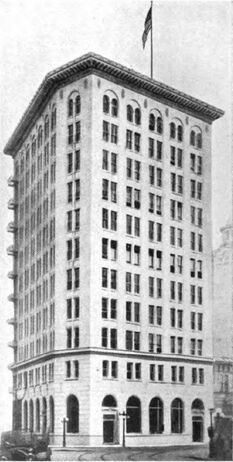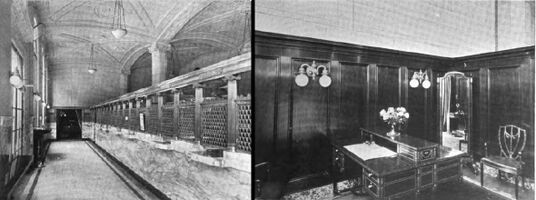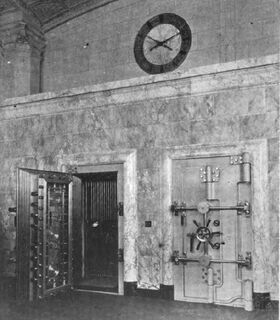First National Gold Bank/First NB, Oakland, CA (Charter 2248)
First National Gold Bank/First NB, Oakland, CA (Chartered 1875 - Liquidated 1924)
Town History
Oakland is the most populous city in and seat of Alameda County, California. A major West Coast port, Oakland is the largest city in the East Bay region of the San Francisco Bay Area, and the third-largest city overall in the Bay Area. With a population of 440,646 in 2020, it serves as the Bay Area's trade center. the Port of Oakland is the busiest port in Northern California, and the fifth- or sixth-busiest in the United States. A charter city, Oakland was incorporated on May 4, 1852, in the wake of the state's increasing population due to the California gold rush.
Oakland's territory covers what was once a mosaic of California coastal terrace prairie, oak woodland, and north coastal scrub. In the late 18th century, it became part of a large rancho grant in the colony of New Spain, and was known for its plentiful oak tree stands. Its land served as a resource when its hillside oak and redwood timber were logged to build San Francisco. The fertile flatland soils helped it become a prolific agricultural region. In the 1850s, what became the first campus of the University of California was founded in Oakland, and Oakland was selected as the western terminal of the Transcontinental Railroad in 1869. The following year, Oakland's Lake Merritt became the United States' first officially designated wildlife refuge, now a National Historic Landmark. Following the catastrophic 1906 San Francisco earthquake, many San Francisco citizens moved to Oakland, enlarging the population, increasing its housing stock, and improving its infrastructure. It continued to grow in the 20th century with its port, shipyards, and manufacturing industry. In the 21st century, between 2019 and 2023, Oakland became the first city in American history to lose three professional major league sports teams to other cities within a span of five years.
Oakland had five National Banks chartered during the Bank Note Era, and four of those banks issued National Bank Notes.
Bank History
- Organized March 30, 1875
- Chartered April 10, 1875
- 2: Liquidated October 11, 1924
- 2: Absorbed by American Bank of San Francisco
In August 1874, at the old post office room, 969 Broadway, one could find President Ferris in Scotch gray, feet up and reading the morning paper in the back office of the new bank. The president of the Alameda County Savings and Loan Society was Hon. B.F. Ferris, president; Israel W. Knox, vice president; L.W. Kennedy, secretary; B.F. Ferris, treasurer; Galen M. Fisher, cashier; Hon. Zach. Montgomery, counsel; and Theo A. Mudge, surveyor. The directors were B.F. Ferris, Henry Durant, Elizah Case, Geo. G. Berry, Zach. Montgomery, Israel W. Knox, John Currey, W. Newcomb, Geo. Tait, Chas. H. Twombly, and L.W. Kennedy.[1]
In January 1875, Oakland had three banks: the Alameda County Savings and Loan Society Bank situated at 969 Broadway, between Ninth and Tenth Streets; Oakland Bank situated at 915 Broadway between Eighth and Ninth Streets; and Union Bank, situated at southeast corner of Broadway and Ninth Street.[2] The officers of the Alameda County Savings and Loan Society were B.F. Ferris, president; E. Case, vice president; G.M. Fisher, cashier; and A.D. Thomson, secretary. The directors were B.F. Ferris, W. Newcomb, J.E. Ruggles, C.H. Trombly, V.D. Moody, Geo. H. Fogg, P.C. Huntley, E. Case, A. Eberhart, V.P. Terry, and S.N. Putnam. The bank was at 969 Broadway, Oakland, with Capital of $500,000 in gold coin.[3] In April 1875, a majority of the board of directors of the Alameda County Savings and Loan Society were organizing a Gold Note Bank. They had complied with the law requiring them to make a deposit at Washington and expected to commence business soon.[4] A window of the Alameda Bank was lettered as follows: "First National Gold Bank, Oakland."[5] Judge Ferris received a certificate from the comptroller of the currency authorizing the First National Gold Bank to commence the business of banking.[6] On Monday, May 24th, the bank commenced business at their banking house 969 Broadway.[7]
On Tuesday, January 14, 1879, the annual meeting of the stockholders of the First National Gold Bank was held at the bank, 969 Broadway, Oakland. The directors were G.M. Fisher, J.E. Baggles, A.J. Snyder, V.D. Moody, I.W. Knox, B.F. Mann, F.W. Williams, C.H. Twombly, and F.K. Shattuck. The officers were V.D. Moody, president; and Chas. H. Twombly, cashier. The bank had capital authorized of $1,000,000 and paid-in capital of $100,000.[8]
In January 1883, the officers were V.D. Moody, president; C.H. Twombly, cashier; and A.D. Thomson, assistant cashier. The directors were A. Chabot, J.E. Ruggles, A.J. Snyder, C.H. Twombly, L.C. Morehouse, B.F. Mann, W.P. Jones, V.D. Moody, and F.K. Shattuck. The bank was at 969 Broadway, Oakland.[9]
In January 1893, at the annual meeting of the stockholders, the directors elected were Arthur D. Thomson, G.W. McNear, P.E. Bowles, G.W. McNear, Jr., C.D. Pierce, L.G. Burpee, W.T. Jones, Wallace Everson, J.S. Cone, L.C. Morehouse and A.J. Snyder. The officers were George W. McNear, president; Arthur D. Thomson, vice president; and L.G. Burpee, cashier.[10]
On December 29, 1909, George W. McNear, one of the best-known grain merchants and operators in the west, principal stockholder in the firm of George W. McNear Inc., died at his home in Oakland. McNear was a powerful figure in the grain trade and about 20 years ago was known as the "Wheat King of California." It was partly through his efforts that the consolidation of the old Produce Exchange and Merchants' Exchange of San Francisco was effected. McNear founded his grain establishment in San Francisco in 1870 and the wheat exporting corporation rapidly developed with branch offices at London and Liverpool. He was born at Wiscasett, Maine, on March 27, 1837. At the age of 15 he was determined to learn seamanship and navigation and went to sea. When he was 18 years of age, he was made a master and for six years commanded sailing vessels and steamers on the Mississippi sound. He moved from New Orleans to California in 1860. With his brother, John A. McNear, he started in the commission business in Petaluma. On November 2nd of this year he celebrated his golden wedding anniversary with his wife who as Miss Amanda M. Church, he married at Bangor, Maine in 1859. His daughter Mary Amanda was married to P.E. Bowles who succeeded him as president of the First National Bank of Oakland. [11]
In January 1910, the officers were P.E. Bowles, president; L.G. Burpee and L.C. Morehouse, vice presidents; E.N. Walter, cashier; S.H. Kitto and C.N. Walter, assistant cashiers. The statement of condition for November 16, 1909, showed total resources of $4,088,558.99 with deposits $2,921,826.72, capital $500,000, surplus and undivided profits $170,032.27 and circulation of $496,700. The bank was located on 14th and Broadway and was affiliated with the First Trust and Savings Bank.[12] The directors were P.E. Bowles, L.C. Morehouse, E.A. Heron, W.H. Taylor, Wallace Everson, E.W. Runyon, H.C. Morris, A.L. Stone, and L.C. Burpee. The directors of the First Trust and Savings Bank were the same except for George D. Metcalf in place of H.C. Morris.[13]
On Tuesday, January 14, 1913, stockholders of the First National Bank of Oakland elected the following directors: P.E. Bowles, L.G. Burpee, L.C. Morehouse, E.A. Heron, E.L. Dow, W.H. Taylor, H.C. Morris, George D. Metcalf, and Wickham Havens. The officers elected were P.E. Bowles, president; L.G. Burpee, L.C. Morehouse, and E.N. Walter, vice presidents; S.H. Kitto, cashier; and C.N. Walter, assistant cashier.[14]
On Tuesday, January 14, 1913, P.E. Bowles, president of the American National Bank of San Francisco since its organization in 1902, resigned and was designated chairman of the board occupying a position created for him by the board of directors. George N. O'Brien who had been connected with the American National for 10 years, serving as vice president for the past two years, was elected president to succeed Mr. Bowles. Francis Cutting was re-elected vice president, Russell Lowry was advanced from cashier to vice president, and D.B. Fuller, formerly assistant cashier, was made cashier. Irving H. Sanborn was re-elected assistant cashier. Stockholders re-elected all members of the board of directors and elected two new members, Mr. H.M.A. Miller, vice president of the Presidia and Ferries Railroad Co., and John A. Britton, first vice president and general manager of the Pacific Gas and Electric Company. The re-elected directors were Francis Cutting, F.A. Somers, P.E. Bowles, C.H. Crocker, James McNab, Frank L. Brown, Gavin McNab, and George N. O'Brien.[15]



The First Trust and Savings Bank was organized by substantially the same interests as those owning the First National Bank of Oakland and its inception was due to the public demand for an institution of this character. Business began on June 1, 1908, and by November 1913, it was deemed expedient to raise the capital from $300,000 to $500,000. The directors in 1914 were L.C. Morehouse, president, First National Bank, San Leandro; E.L. Dow, capitalist; H.C. Morris, president, Pratt-Low Preserving Company; W.H. Taylor of Taylor & Co., lumber; L.G. Burpee, vice president, First National Bank, Oakland; E.A. Heron, capitalist; P.E. Bowles, president; George D. Metcalf, vice president; and O.D. Jacoby, cashier.
The First Trust and Savings Bank building was 11 stories recently completed. The exterior was encased in Manti stone with a beautiful whitish buff color, quarried in Utah. Over the entrance doors of the bank there was a coat of arms representing the various activities of the bank with a naturalistic squirrel at each side of the shield to typify the savings tendency and also the intelligent enjoyment of such savings. At the corner on San Pablo Avenue was a unique bank sign consisting of a gold-plated shield with an etched border ornament having incorporated many of the choicest coins of Greece and Rome. The background of this ornament was in royal purple jewelers' enamel which also formed the main body of the letters. The ceiling was modeled by expert sculptors and recalled early scenes of California's history, illustrated by circular and octangular medallions with the names of early pioneers and other prominent men active in the development of the state. The bank screen was of gold bronze and plate glass above the counter line, but the counter screen was composed of selected Skyros marble specially imported from Greece for this purpose. In order to instill into the minds of the youthful depositors lessons of thrift and integrity, selections of Poor Richard's sayings, formed into an ornamental border of 2 1/2 inch bronze letters, were set in colored cement around the entire marble floor of the lobby.[19]
In January 1923, announcement of the purchase of control of the Security Bank and Trust Company by the American National Bank, both of San Francisco, was made by President Philip E. Bowles of the latter bank. The price agreed upon was $172.50 per share of the Security Bank which had resources of $7 million. Bowles, who was also president of the First National Bank and the American Bank of Oakland, had not yet decided where the Security Bank would fit into the organization. The Bowles organization comprised in addition to the American National Bank of San Francisco and the First National and American banks of Oakland numerous branches in Oakland, Berkeley and Piedmont, and banks in Modesto, Tracy, Livermore and Martinez. The Security Bank and trust Co. was founded in 1871 by William Babcock and other pioneer businessmen of San Francisco as the Security Savings Bank.[20]
On Tuesday, January 8, 1924, officers of the American Bank of Oakland were named at the annual meeting of directors and stockholders. Those chosen were P.E. Bowles, president; O.D. Dinsmore, vice president; F.D. Moyer, cashier; F.E. Crichton, A.E. Little, C.F. William, assistant cashiers; F.W. Howsmer, vice president and manager, Modesto branch; J.S. Mills, assistant cashier and manager, Berkeley branch; R.S. Padget, assistant cashier and assistant manager, Berkeley branch; F.N. Kornhaus, assistant cashier and manager, Fruitvale branch; Robert MacNour, Jr., assistant cashier and manager, Dimond branch; L.C. Whitby, manager, West Oakland branch; M.D. McLeod, manager, Piedmont branch; W.P. Stone, manager Emeryville branch.[21]
The directors of the First National called a special meeting of the stockholders on Tuesday, October 7th, 1924, to consider and act upon a proposal to liquidate the bank and sell the business assets and property to The American Bank of San Francisco.[22] On October 27th, the American Bank announced that the State Superintendent of Banks had granted exclusive privilege of operating a branch in the Grand Avenue district at the head of Lake Merritt. The new branch followed closely on the heels of the merger between the American Bank of Oakland, the Frist National Bank of Oakland and the American Bank of San Francisco, and the purchase of the First National Bank of San Leandro, the Bank of San Leandro, and the Elmhurst Branch of the Bank of San Leandro.[23]
Official Bank Titles
1: The First National Gold Bank of Oakland, CA
2: The First National Bank of Oakland, CA (3/8/1880)
Bank Note Types Issued
A total of $6,709,700 in National Bank Notes was issued by this bank between 1875 and 1924. This consisted of a total of 739,176 notes (739,176 large size and No small size notes).
This bank issued the following Types and Denominations of bank notes:
Series/Type Sheet/Denoms Serial#s Sheet Comments 1: Original Series 3x10-20 1 - 1600 Gold 1: Series 1875 3x10-20 1 - 12 Gold 2: Series 1875 3x10-20 1 - 6405 2: 1882 Brown Back 4x5 1 - 7500 2: 1882 Brown Back 3x10-20 1 - 9500 2: 1882 Brown Back 50-100 1 - 1784 2: 1882 Date Back 4x5 1 - 23935 2: 1882 Date Back 3x10-20 1 - 14396 2: 1882 Date Back 50-100 1 - 700 2: 1882 Date Back 3x50-100 1 - 1528 2: 1902 Date Back 4x5 1 - 8250 2: 1902 Date Back 3x10-20 1 - 6700 2: 1902 Plain Back 4x5 8251 - 73435 2: 1902 Plain Back 3x10-20 6701 - 45241
Bank Presidents and Cashiers
Bank Presidents and Cashiers during the National Bank Note Era (1875 - 1924):
Presidents:
- Benjamin Franklin Ferris, 1875-1875
- Volney Delos Moody, 1876-1890
- Arthur Dalliba Thomson Sr., 1891-1892
- George Washington McNear, 1893-1895
- Philip Ernest Bowles, 1896-1912
- Edward Rodden, 1913-1913
- Philip Ernest Bowles, 1914-1915
- Russell Lowry, 1916-1918
- Philip Ernest Bowles, 1919-1924
Cashiers:
- Galen Merriam Fisher, 1875-1877
- Charles Henry Twombly Sr., 1878-1882
- Arthur Dalliba Thomson Sr., 1883-1890
- Lester G. Burpee, 1891-1905
- Edwin Nelson Walter, 1906-1911
- Samuel H. Kitto, 1912-1912
- William Lindsay Rodden, 1913-1913
- Samuel H. Kitto, 1914-1922
- Alfred J. Anderson, 1923-1924
Other Known Bank Note Signers
Bank Note History Links
- First National Gold Bank/First NB, Oakland, CA History (NB Lookup)
- California Bank Note History (BNH Wiki)
Sources
- Oakland, CA, on Wikipedia
- Huntoon, Peter, "National Gold Banks and National Gold Bank Notes," The Encyclopedia of U.S. National Bank Notes, Chapter B03.
- Don C. Kelly, National Bank Notes, A Guide with Prices. 6th Edition (Oxford, OH: The Paper Money Institute, 2008).
- Dean Oakes and John Hickman, Standard Catalog of National Bank Notes. 2nd Edition (Iola, WI: Krause Publications, 1990).
- Banks & Bankers Historical Database (1782-1935), https://spmc.org/bank-note-history-project
- ↑ Oakland Tribune, Oakland, CA, Sat., Aug. 1, 1874.
- ↑ Oakland Tribune, Oakland, CA, Wed., Jan. 20, 1875.
- ↑ Oakland Tribune, Oakland, CA, Mon., Jan. 18, 1875.
- ↑ Oakland Tribune, Oakland, CA, Tue., Apr. 13, 1875.
- ↑ Oakland Tribune, Oakland, CA, Wed., Apr. 28, 1875.
- ↑ Oakland Tribune, Oakland, CA, Mon., Apr. 26, 1875.
- ↑ Oakland Tribune, Oakland, CA, Sat., May 22, 1875.
- ↑ Oakland Tribune, Oakland, CA, Sat., Jan. 11, 1879.
- ↑ The Morning Times, Oakland, CA, Sat., Jan. 13, 1883.
- ↑ Oakland Tribune, Oakland, CA, Wed., Jan. 11, 1893.
- ↑ Petaluma Argus-Courier, Petaluma, CA, Thu., Dec. 30, 1909.
- ↑ Oakland Enquirer, Oakland, CA, Sat., Jan. 1, 1910.
- ↑ Oakland Enquirer, Oakland, CA, Tue., Jan. 11, 1910.
- ↑ Oakland Tribune, Oakland, CA, Tue., Jan. 14, 1913.
- ↑ The San Francisco Examiner, Wed., Jan. 15, 1913.
- ↑ The Bankers' Magazine, Vol. 89, July - Dec. 1914, p. 68.
- ↑ The Bankers' Magazine, Vol. 89, July - Dec. 1914, p. 69.
- ↑ The Bankers' Magazine, Vol. 89, July - Dec. 1914, p. 70.
- ↑ The Bankers' Magazine, Vol. 89, July - Dec. 1914, pp 68-71.
- ↑ Oakland Enquirer, Oakland, CA, Wed., Jan. 10, 1923.
- ↑ Martinez Daily Standard, Martinez, CA, Wed., Jan. 9, 1924.
- ↑ Oakland Tribune, Oakland, CA, Sat., Sep. 6, 1924.
- ↑ Oakland Tribune, Oakland, CA, Mon., Oct. 27, 1924.







